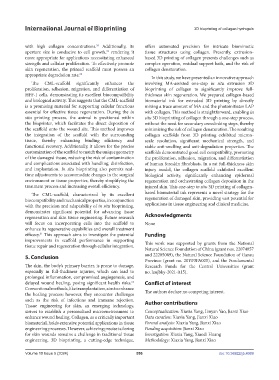Page 564 - IJB-10-5
P. 564
International Journal of Bioprinting 3D bioprinting of collagen hydrogels
with high collagen concentrations. Additionally, its offers automated precision for intricate biomimetic
58
aperture size is conducive to cell growth, rendering it tissue structures using collagen. Presently, extrusion-
59
more appropriate for applications necessitating enhanced based 3D printing of collagen presents challenges such as
strength and cellular proliferation. To effectively promote complex operation, residual support bath, and the risk of
skin regeneration, the printed scaffold must possess an collagen denaturation.
appropriate degradation rate. 60
In this study, we have presented an innovative approach
The CML-scaffold significantly enhances the involving MA-assisted one-step in situ extrusion 3D
proliferation, adhesion, migration, and differentiation of bioprinting of collagen to significantly improve full-
HFF-1 cells, demonstrating its excellent biocompatibility thickness skin regeneration. We prepared collagen-based
and biological activity. This suggests that the CML-scaffold biomaterial ink for extruded 3D printing by directly
is a promising material for supporting cellular functions mixing a trace amount of MA and the photoinitiator LAP
essential for effective tissue regeneration. During the in with collagen. This method is straightforward, enabling in
situ printing process, the animal is positioned within situ 3D bioprinting of collagen through a one-step process,
the bioprinter, which facilitates the direct deposition of without the need for secondary crosslinking steps, thereby
the scaffold onto the wound site. This method improves minimizing the risk of collagen denaturation. The resulting
the integration of the scaffold with the surrounding collagen scaffolds from 3D printing exhibited micron-
tissue, thereby enhancing binding efficiency and scale resolution, significant mechanical strength, and
functional recovery. Additionally, it allows for the precise stable anti-swelling and anti-degradation properties. The
customization of the scaffold to match the unique geometry scaffolds demonstrated good cell compatibility, promoting
of the damaged tissue, reducing the risk of contamination the proliferation, adhesion, migration, and differentiation
and complications associated with handling, disinfection, of human foreskin fibroblasts. In a rat full-thickness skin
and implantation. In situ bioprinting also permits real- injury model, the collagen scaffold exhibited excellent
time adjustments to accommodate changes in the surgical biological activity, significantly enhancing epidermal
environment or tissue properties, thereby simplifying the regeneration and orchestrating collagen deposition in the
treatment process and increasing overall efficiency. injured skin. This one-step in situ 3D printing of collagen-
The CML-scaffold, characterized by its excellent based biomaterial ink represents a novel strategy for the
biocompatibility and mechanical properties, in conjunction regeneration of damaged skin, providing vast potential for
with the precision and adaptability of in situ bioprinting, applications in tissue engineering and clinical medicine.
demonstrates significant potential for advancing tissue
regeneration and skin tissue engineering. Future research Acknowledgments
will focus on incorporating cells into the scaffold to None
enhance its regenerative capabilities and overall treatment
efficacy. This approach aims to investigate the potential Funding
61
improvements in scaffold performance in supporting This work was supported by grants from the National
tissue repair and regeneration through cellular integration.
Natural Science Foundation of China (grant nos. 22074057
5. Conclusion and 22205089), the Natural Science Foundation of Gansu
Province (grant no. 20YF3FA025), and the Fundamental
The skin, the body’s primary barrier, is prone to damage, Research Funds for the Central Universities (grant
especially in full-thickness injuries, which can lead to no. lzujbky-2021-it15).
prolonged inflammation, compromised angiogenesis, and
delayed wound healing, posing significant health risks. Conflict of interest
62
Conventional methods, like transplantation, aim to enhance The authors declare no competing interest.
the healing process; however, they encounter challenges
such as the risk of infections and immune rejection. Author contributions
Tissue engineering for skin, an emerging technology,
strives to establish a personalized microenvironment to Conceptualization: Xiaxia Yang, Linyan Yao, Jianxi Xiao
enhance wound healing. Collagen, as a critically important Data curation: Xiaxia Yang, Jianxi Xiao
biomaterial, holds extensive potential applications in tissue Formal analysis: Xiaxia Yang, Jianxi Xiao
engineering processes. However, achieving precise tailoring Funding acquisition: Jianxi Xiao
for skin wounds remains a challenge in traditional tissue Investigation: Xiaxia Yang, Xiaodi Huang
engineering. 3D bioprinting, a cutting-edge technique, Methodology: Xiaxia Yang, Jianxi Xiao
Volume 10 Issue 5 (2024) 556 doi: 10.36922/ijb.4069

